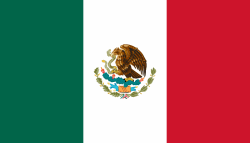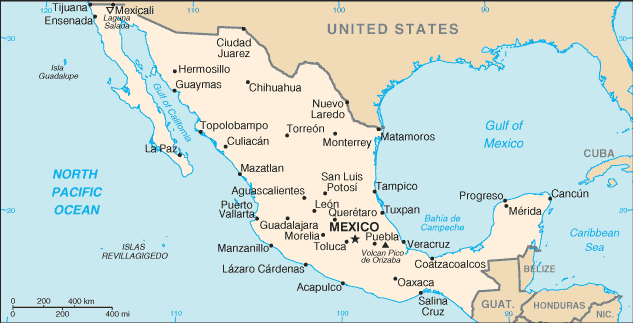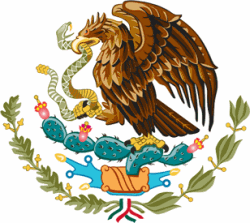United Mexican States
Related Categories:
 Flag of Mexico
Flag of MexicoThree equal vertical bands of green (hoist side), white, and red; the coat of arms (an eagle perched on a cactus with a snake in its beak) is centered in the white band. |

 Mexico Coat of Arms
Mexico Coat of Arms |
The Mexican flag embodies the rich history of Mexico by evolving from at least three different traditions: the indigenous, the colonial and hispanic religious heritage and the liberal force that advocated the creation of independent sovereign states.
www.geocities.com/
Origin and meaning of the Mexican flag.
www.fotw.us/flags/mx.html Mexico - wikipedia.org
As the only Latin American member of the Organization for Economic Co-operation and Development since 1994, Mexico is firmly established as an upper middle-income country.
en.wikipedia.org/
Mexico is the most populous Spanish-speaking country in the world and the second most-populous country in Latin America after Portuguese-speaking Brazil. About 70% of the people live in urban areas. Many Mexicans emigrate from rural areas that lack job opportunities--such as the underdeveloped southern states and the crowded central plateau--to the industrialized urban centers and the developing areas along the U.S.-Mexico border. According to some estimates, the population of the area around Mexico City is about 18 million, which would make it the largest concentration of population in the Western Hemisphere. Cities bordering on the United States--such as Tijuana and Ciudad Juarez--and cities in the interior--such as Guadalajara, Monterrey, and Puebla--have undergone sharp rises in population in recent years.
Education is among the Mexican government’s highest priorities, and the education budget has continued to grow in recent years. Funding for education increased from 6.9 % of GDP in 2002 to 7.3% of GDP in 2005. While efforts to decentralize responsibility for education from the federal to the state level in order to improve accountability are ongoing, the central government still retains significant authority. Although educational performance in Mexico has improved substantially in recent decades, the country still faces several major problems, including providing education to rural and indigenous populations.
Education is currently mandatory for ages 5 through 15. An education reform law enacted in 2002 will make preschool mandatory for all children ages 3 and up by 2008. This reform is being implemented in stages. In 2005, 77.4% of the population between the ages of 3 and 15 were enrolled in school. Primary, including preschool, enrollment totaled 18.8 million in 2005. Enrollment at the secondary public school level rose from 5.4 million in 2000 to 5.9 million in 2005. After a significant increase in higher education enrollment during previous decades, Mexico has seen a slower rise in university enrollment more recently. Numbers rose from 2 million enrolled in 2000 to 2.4 million in 2005.
www.state.gov/r/
Introduction
About
Contact
Symbols in The News
Interpret this Symbol
AAC
African
AI
Alchemy
Alphabets
Ancient
Animal Symbolism
Architecture
Art
Articles
Astrology
Baha'i
Blissymbolics
Blueprint Symbols
Buddhist
Celtic Symbols
Cemetery
Chinese Symbols
Christian
Circle
City
Codes
Color
Conlangs
Crop Circles
Danger
Da Vinci Code
Designing Logos
Dictionaries
Dreams
Education
Egyptian Symbols
Electrical
Emoticons
Find Images
Fonts
Food
Fraternity
Hamsa
Healing
Heraldry
Hermetic
Highway Signs
Hindu
History
Hobo
Holiday
Icons
iConji
Islamic
Jain Symbols
Japanese, Kanji
Jewish
Justice
Law
Literary Symbolism
Mandalas
Map
Masonic
Math, Number
Meaning of Names
Medical
Middle East
Military
Miscellaneous
Money
Music
Mythology
Native American
Playing Cards
Power
Psychology
QiQiiKhu
Reiki
Religious
Runes, Norse
Sacred Geometry
Scientific
Science Fiction
Sorority
Sports
Symbols in the News
Tattoos
ThirteenSymbols
Tree of Life
Ursprache
Videos
Visual Languages
Weather
Web Codes
Wicca
Words
Writing Systems
Braille
Coinherence
Coptic
Cuneiform
Easter Island
Etruscan
Happy Human
Hebrew
Kokopelli
Linear B
Lotus
Love Symbols
Mandorla
Moon Alphabet
Nine Pointed Star
Om
Oz
Phonetic
Scarab Beetle
Silent
Theosophy
Unifon
About
Contact
Symbols in The News
Interpret this Symbol
AAC
African
AI
Alchemy
Alphabets
Ancient
Animal Symbolism
Architecture
Art
Articles
Astrology
Baha'i
Blissymbolics
Blueprint Symbols
Buddhist
Celtic Symbols
Cemetery
Chinese Symbols
Christian
Circle
City
Codes
Color
Conlangs
Crop Circles
Danger
Da Vinci Code
Designing Logos
Dictionaries
Dreams
Education
Egyptian Symbols
Electrical
Emoticons
Find Images
Fonts
Food
Fraternity
Hamsa
Healing
Heraldry
Hermetic
Highway Signs
Hindu
History
Hobo
Holiday
Icons
iConji
Islamic
Jain Symbols
Japanese, Kanji
Jewish
Justice
Law
Literary Symbolism
Mandalas
Map
Masonic
Math, Number
Meaning of Names
Medical
Middle East
Military
Miscellaneous
Money
Music
Mythology
Native American
Playing Cards
Power
Psychology
QiQiiKhu
Reiki
Religious
Runes, Norse
Sacred Geometry
Scientific
Science Fiction
Sorority
Sports
Symbols in the News
Tattoos
ThirteenSymbols
Tree of Life
Ursprache
Videos
Visual Languages
Weather
Web Codes
Wicca
Words
Writing Systems
Braille
Coinherence
Coptic
Cuneiform
Easter Island
Etruscan
Happy Human
Hebrew
Kokopelli
Linear B
Lotus
Love Symbols
Mandorla
Moon Alphabet
Nine Pointed Star
Om
Oz
Phonetic
Scarab Beetle
Silent
Theosophy
Unifon
